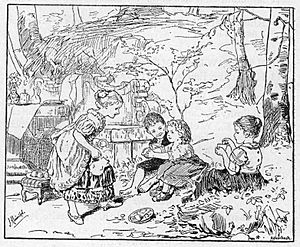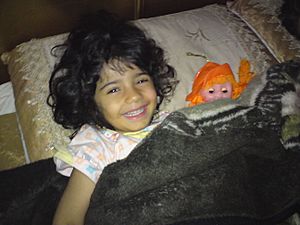House (game) facts for kids
Playing house is a classic game that many kids enjoy. It's a type of make believe or role-playing game. In this game, players pretend to be members of a nuclear family. Common roles include parents, children, a baby, or even pets. It's a fun way to act out grown-up life and explore different family situations.
Players often use everyday items as props. Things like toy food, pretend phones, or even blankets can become part of the game. Dolls are also popular for playing the roles of family members. Some toys, like model houses and play kitchens, are made just for playing house. Kids play this game at home, in kindergarten, or at day care centers. It helps them understand social roles and practice being part of a family.
Contents
Playing House Around the World
This game is popular in many countries, though its name and how it's played can differ. It shows how kids everywhere like to imagine and learn about family life.
Names in Different Cultures
- In Persian, the game is called "mother play" or "auntie play." These names show that girls often play these roles.
- Similarly, in Russian, it's called дочки-матери, which means "daughters-and-mothers."
- In German, the game is known as "Mutter, Vater, Kind." This translates to "mother, father, child."
- In Chinese, it's called "扮家家酒" or "过家家." These names mean "playing/living a family."
- In Dutch, the game is called "vadertje en moedertje." This means "little father and little mother."
- In Japanese, the game is known as "ままごと" (mamagoto), which means "playing house."
Why Kids Play House
Playing house is more than just fun. It helps kids learn important skills. When children pretend to be adults, they practice social interactions. They learn about different roles and responsibilities within a family. This type of play also helps them understand emotions and solve problems. It's a great way for kids to use their imagination and creativity. They can create their own stories and scenarios, which builds their thinking skills.
Images for kids





